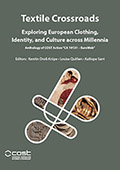Centre for Textile Research

Textile Crossroads: Exploring European Clothing, Identity, and Culture across Millennia
Date of this Version
2024
Document Type
Article
Citation
In Textile Crossroads: Exploring European Clothing, Identity, and Culture across Millennia. Anthology of COST Action “CA 19131 – EuroWeb”. Kerstin Droß-Krüpe, Louise Quillien, & Kalliope Sarri, Editors. Zea Books, Lincoln, Nebraska, 2024. DOI: 10.32873/unl.dc.zea.1803
Abstract
Dress, clothes, and accessories receive and give meaning through their nearness to the human body. As P. Stallybrass writes: “Bodies come and go: the clothes that have received those bodies survive.” It is through the close interaction between dress and person that they both receive their meaning. Clothes shape the human body, and we in return shape our clothes. Dress communicates class, gender, nationality, and marital status, and we leave behind parts of us in its smell, wrinkles, wear, and tear: “Clothes receive the human imprint.” Archaeological and historical dress — no matter how ancient — remain intrinsically linked to their wearers. These are objects of use, affection, value, and memory, and through the study of the dress of past people, we may wear their habits and inhabit their spaces however briefly.
The visual appearance of people, in more recent times as well as throughout history, is a clear marker of identity and an important communication medium. For this reason, costume and jewelry serve as an “anchor point” to involve people of the 21st century in studies of the life of prehistoric and ancient societies. This is worth considering, as archaeological textile research needs a strong commitment to public outreach and education, as well as to be integrated into the challenges of our time and to participate in current debates. Through the lens of deep history, it can inspire people to think about such questions as identity, resource use, and shared heritage, among others. Dissemination of textiles and clothing for the broader public in museums is realized through various channels. These range from the exhibition of individual objects, such as textiles, garments, jewelry, and dress accessories, to virtual recreations, and encompasses workshops, citizen science projects for the recreation of historical garments, media-effective historical fashion shows, and reinterpretations of aspects of historical garments through contemporary fashion. This remains an ongoing process, since the interpretation of the past will never be complete, and every generation formulates new approaches. The EuroWeb COST Action (2020–2024) serves as an innovative hub to gain understanding of historical as well as recent dress identities. For this contribution, different aspects of the history of fashion from various museums have been selected as case studies, to demonstrate the wide span of possibilities for displaying and experiencing Dress Identities. Our journey starts with Etruscan jewelry as displayed at the Staatliche Antikensammlungen in Munich (Germany), leading to Early Medieval dress, recreated from various sources as a physical dress ensemble as well as a virtual one, and used for science communication at the Natural History Museum Vienna (Austria) and Halle an der Saale (Germany). As both of the first examples derive from archaeological contexts, we do not have complete garments. This was why we also wanted to explore the possibilities for dissemination of “folk historic costumes”, like a traditional mourning dress as displayed at the Museum Amager (Denmark).
Included in
Ancient History, Greek and Roman through Late Antiquity Commons, Archaeological Anthropology Commons, Classical Archaeology and Art History Commons, Classical Literature and Philology Commons, Eastern European Studies Commons, European History Commons, European Languages and Societies Commons, Fiber, Textile, and Weaving Arts Commons, History of Science, Technology, and Medicine Commons, Human Geography Commons, Museum Studies Commons, Place and Environment Commons, Social and Cultural Anthropology Commons, Women's Studies Commons


Comments
Copyright © 2024 by the authors.